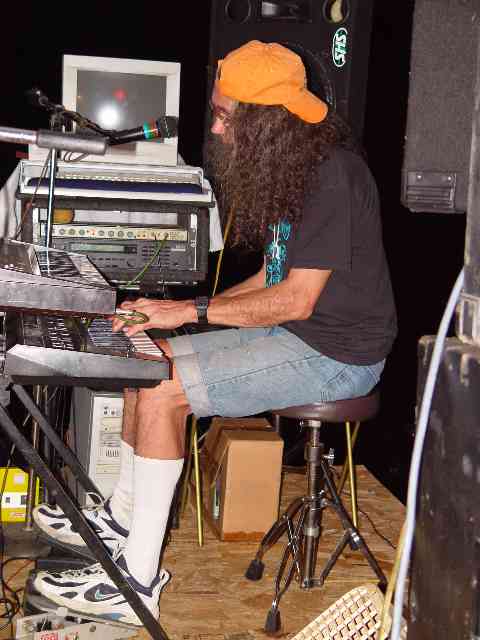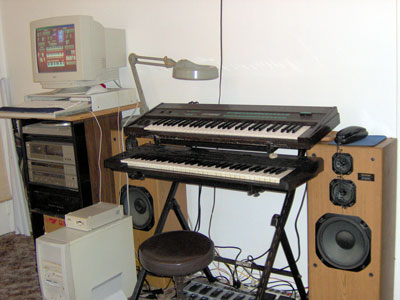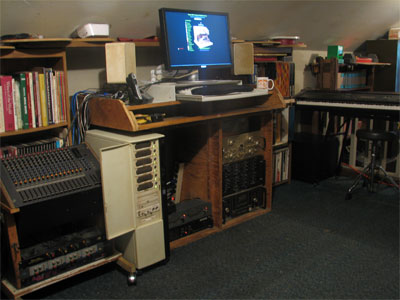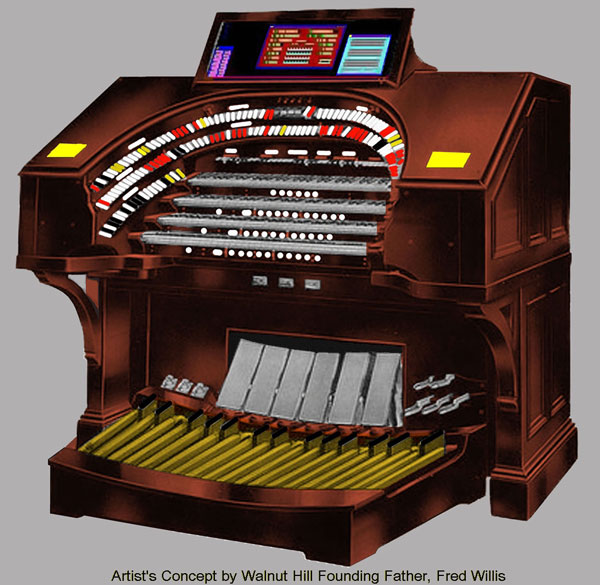
|
|
In The Beginning...A Man And A DreamThis is a picture of the Bone Doctor playing an early version of his Virtual Theatre Pipe Organ at a live concert in Six Mile, Blount County, Tennessee during the late summer of 2001. In those days, he played this machine along with a blues band knwn as Mojo. The rig was to undergo drastic changes in the days ahead as technology progressed and Walnut Hill was founded in the spring of 2003, and later relocated to the city of Clearwater in sunny Florida in the late summer of 2005. This instrument is not a real pipe organ. It is a virtual model created by computers and software. It does not have an actual organ console in the conventional sense as Theatre Pipe Organs go. As a matter of fact, it does not look like an organ at all if you look at it today in the studio at Walnut Hill in Clearwater, Florida. The Installation in Clearwater, FloridaAbove can be seen the Walnut Hill Virtual Theatre Organ running the Mighty MidiTzer Style 216 sitting in the studio/living room at Walnut Hill Manor in Clearwater, Florida. To the right of this machine is the vintage 1964 Conn 640 Vacuum Tube Theatre Organ, out of the view of this picture. In the early days when Walnut Hill was still in Maryville, Tennessee, the virtual organ computer was a rather humble AMD® K6-2 500MHz rig running Windows98® Second Edition. Today, it has been upgraded to a Intel® P4 2.0GHz 400MHz FSB workstation running WindowsXP® Pro SP2 built in the original tower, seen to the left of and below the keyboards in the picture above. The installation in Clearwater consisted of two digital 61-note MIDI controllers, a Yamaha DX-7 and a Korg DW-800 Wavestation, and two powerful WinTel computers with lots of outboard gear, very powerful amplifiers and reference loadspeakers. We have aquired a 32-note AGO pedalboard courtisy of Harold Wipps in Manatee County, which we shall be incorporating in the very near future as soon as we get it wired with magnetic reed switches and add the MIDI encoders to be supplied by Vern Jones at Sound Research. The first computer is controlled by the MIDI keyboard and outputs audio to the second computer. Cakewalk® Pro Audio 9.01 runs on the first machine and Sound Forge® 6 runs on the second one. The musician plays the controller, causing MIDI events to be recorded on the first computer. After all the tracks are layed down, they are mixed down to stereo onto the second computer. The second machine is a monster Intel® P4 2.4GHz 400MHz FSB server running WindowsXP® Pro SP2 that sits in the control room/bedroom at Walnut Hill Manor. Both machines were custom built by CoyoteNET® Digital System Solutions using heavy duty high-end components mounted in large cases. The Installation in Alcoa, TennesseeWhen the company moved to Alcoa, Tennesseein August of 2006, the virtual organ equipment was put into secure climate controlled storage until suitable facilities could be procured in which to set it up once again. In the picture above, we see the main data server flanked on the left by the Electrovoice/Dynacord mixing desk and on the right, the Peavy 88-note MIDI controller used to enter keystrokes into the VTPO under development at Walnut Hill. The Planned Virtual 4/36 Mighty WurliTzer ConsoleWe do plan to build a real four-manual Empire Special style console in the future as time and money allow. Click here to download a 1093 x 1065 artist's rendering of the planned console by Walnut Hill Founding Father, Fred Willis. This console looks strickingly similar to the J. Tyson Forker Memorial 4/32 Mighty WurliTzer Theatre Pipe Organ installed at Grace Baptist Church in Sarasota, Florida. However, it is more like the famous Granada WurliTzer. The main differences are a darker red Walnut finish, a slighty wider horseshoe, six swell shoes (Main, Solo, Antiphonal, Ethereal, Master and Crescendo), five double-touch piano pedals and a music rack that is a widescreen LCD display which is touch sensative. The console will easily separate into two sections, the keydesk and the pedistal. The keydesk will house the manuals, stops, and combination action. The pedistal will house the computer, uninterruptable power supply, I/O connections and swell shoe assembly. The pedalboard will detach from the pedistal. We estimate the total cost of the project to be about 300,000 dollars. We plan to power the console with an Intel dual Xeon server running Windows 2003 Advanced Server hosting a custom four-manual version of the jOrgan with 36 ranks and a complete toy counter. Stay tuned as we approach a final design for this massive instrument. |



